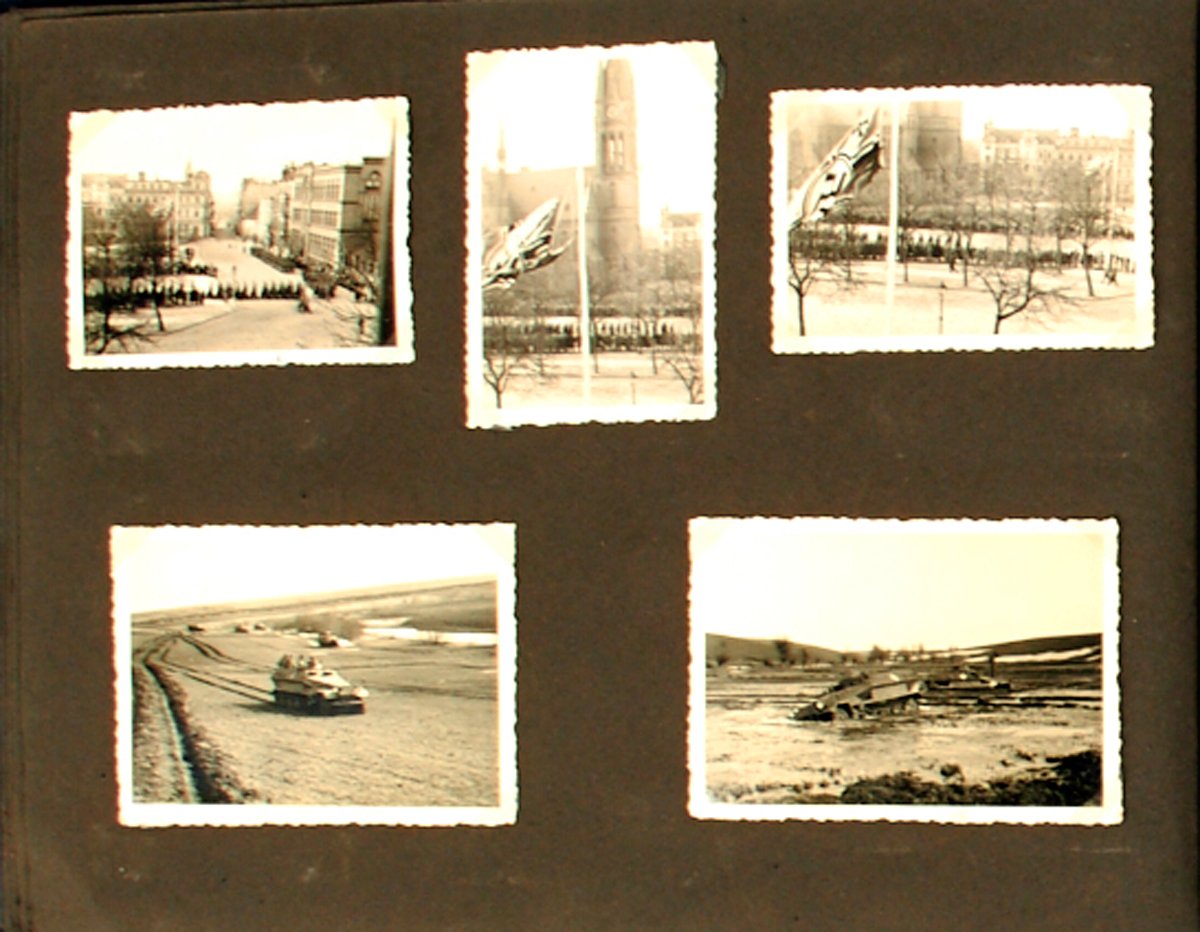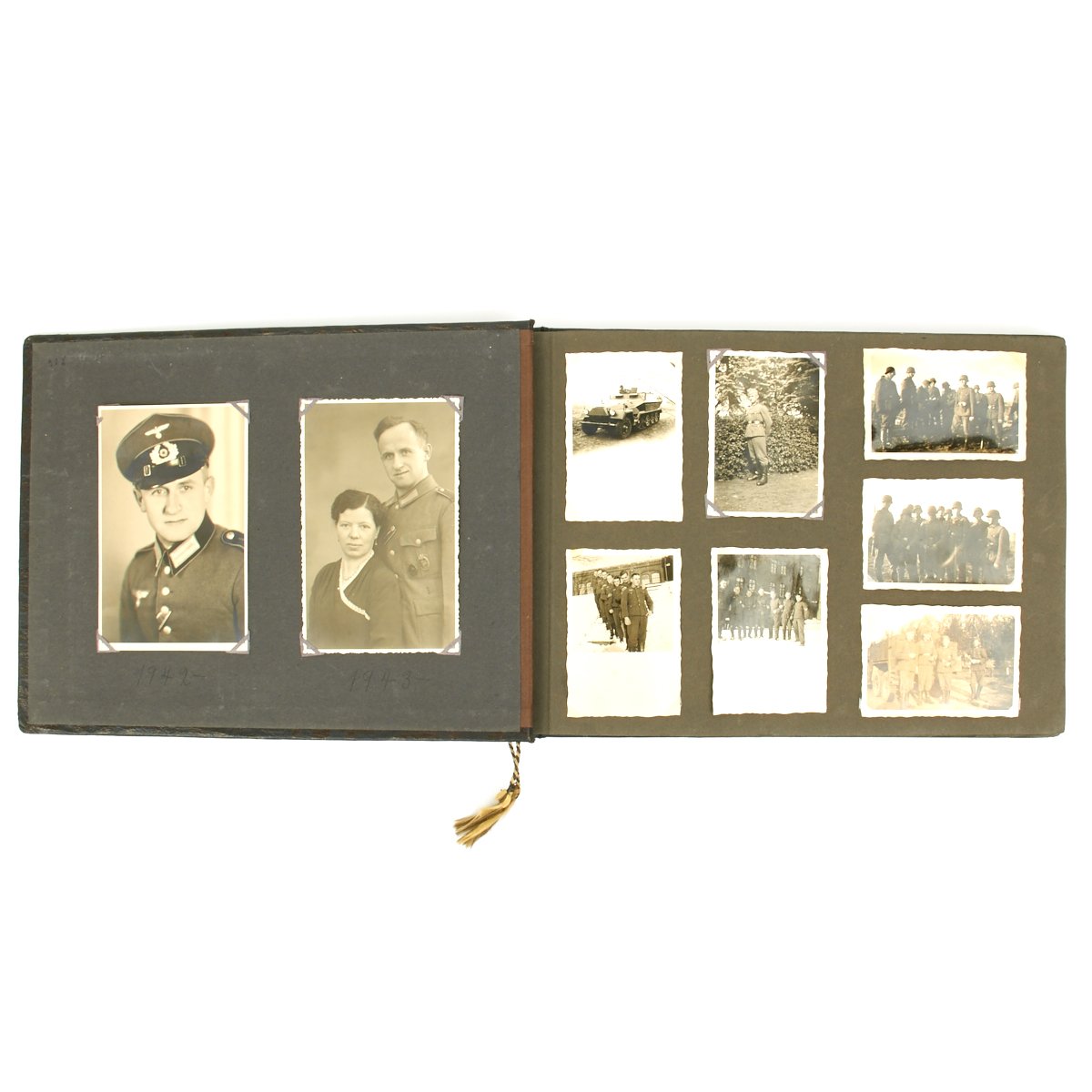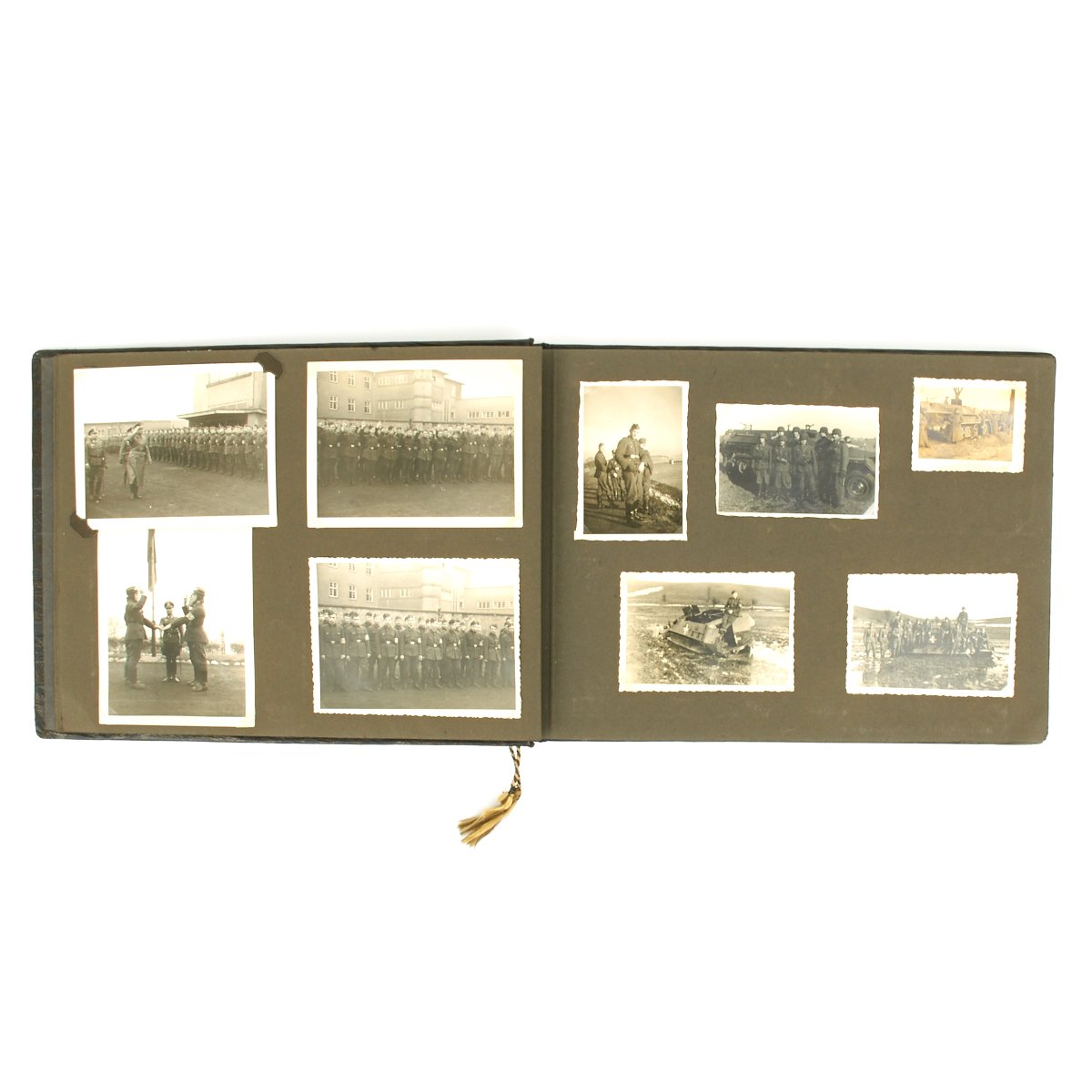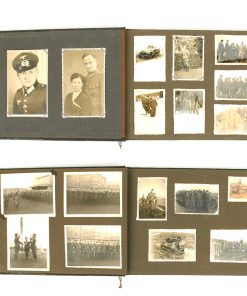Original German WWII 1942-1943 Panzer Grenadier NCO Photo Album – 300 Photos Original Items
$ 495,00 $ 148,50
Original Item: Only One Available. This is an incredible photo album that dates from 1942-1943 of a German WWII Panzer Grenadier Non-Commissioned Officer. The album is 50 pages in length and contains 300 photos!
The album features multiple photos of the very rare SdKfz 251 half-track (same type of vehicle that Matt Damon blew up with a bazooka in Saving Private Ryan). There is even a series of photos showing a SdKfz 251 stuck in deep mud. Almost all photos a military related, the inside cover is marked 1942-1943 which is consistent with the creation of the Panzer Grenadiers. 90% of the photos show a soldier or more in uniform and vary in season and geography (country to town) as well as official celebrations and even Christmas. Other equipment featured are mortars, rangefinders, optics, machine guns, bicycles, panzerfaust, various vehicles including a captured U.S. Willys Jeep! All photos are held in place with corner braces indicating that this album was put together in the period and not some crazy post war creation.
The album cover is an attractive, deeply textured leatherette with a finely detailed metal Army eagle in the upper left and the words Kriegserinnerungen (War Memories) embossed in gold on the lower right.
The Sd.Kfz. 251 (Sonderkraftfahrzeug 251) half-track was a WW2 German armored fighting vehicle designed by the Hanomag company, based on its earlier, unarmored Sd.Kfz. 11 vehicle. The Sd.Kfz. 251 was designed to transport the panzergrenadiers (German mechanized infantry) into battle. Sd.Kfz. 251s were the most widely produced German half-tracks of the war, with at least 15,252 vehicles and variants produced by various manufacturers, and were commonly referred to simply as “Hanomags” by both German and Allied soldiers.
The use of armored half-tracks was rare in the German Army, and even the elite Großdeutschland Division, with two panzergrenadier regiments, only mustered a few companies’ worth of the vehicles, generally SdKfz 251 troop carriers. The vast majority of Schützen/Panzergrenadier soldiers were mounted in trucks. Additionally, vehicles in the early war period suffered from poor off-road performance.
The term Panzergrenadier had been introduced in 1942, and was applied equally to the infantry component of Panzer divisions as well as the new divisions known as Panzergrenadier Divisions. Most of the Heer’s PzGren. divisions evolved via upgrades from ordinary infantry divisions, first to Motorized Infantry divisions and then to PzGren. divisions, retaining their numerical designation within the series for infantry divisions throughout the process. This included the 3rd, 10th, 14th, 15th, 16th, 18th, 20th, 25th, and 29th divisions. Others, such as the Großdeutschland Division, were built up over the course of the war by repeatedly augmenting the size of an elite regiment or battalion. The Waffen-SS also created several PzGren. divisions by the same methods, or by creating new divisions from scratch later in the war. A number of PzGren. divisions in both the Heer and Waffen-SS were upgraded to Panzer divisions as the war progressed.
The Panzergrenadier divisions were organized as combined arms formations, usually with six battalions of truck-mounted infantry organized into either two or three regiments, a battalion of tanks, and an ordinary division’s complement of artillery, reconnaissance units, combat engineers, anti-tank and anti-aircraft artillery, and so forth. All these support elements would also be mechanized in a PzGren. division, though most of the artillery, anti-tank, and anti-aircraft elements were equipped with weapons towed by trucks rather than the relatively rare armored and self-propelled models. In practice the PzGren. divisions were often equipped with heavy assault guns rather than tanks, due to a chronic shortage of tanks throughout the German armed forces. A few elite units, on the other hand, might have the tanks plus a battalion of heavy assault guns for their anti-tank element, and armored carriers for some of their infantry battalions as well.
On paper a Panzergrenadier division had one tank battalion less than a Panzer division, but two more infantry battalions, and thus was almost as strong as a Panzer division, especially on the defensive. Of 226 panzergrenadier battalions in the whole of the German Army, Luftwaffe and Waffen SS in September 1943, only 26 were equipped with armored half tracks, or just over 11 percent. The rest were equipped with trucks.
This is one of the nicest and rarest, due to the content, German WWII photo album weve ever encountered!
Fast Shipping with Professional Packaging
Thanks to our longstanding association with UPS FedEx DHL, and other major international carriers, we are able to provide a range of shipping options. Our warehouse staff is expertly trained and will wrap your products according to our exact and precise specifications. Prior to shipping, your goods will be thoroughly examined and securely secured. We ship to thousands clients each day across multiple countries. This shows how we're dedicated to be the largest retailer on the internet. Warehouses and distribution centres can be located throughout Europe as well as the USA.
Note: Orders with more than one item will be assigned a processing date depending on the item.
Before shipping before shipping, we'll conduct a thorough inspection of the items you have ordered. Today, the majority of orders will be delivered within 48 hours. The delivery time will be between 3-7 days.
Returns
The stock is dynamic and we cannot completely manage it because multiple stakeholders are involved, including our factory and warehouse. So the actual stock may alter at any time. It's possible that you may not receive your order once the order has been made.
Our policy is valid for a period of 30 days. If you don't receive the product within 30 days, we are not able to issue a refund or an exchange.
You can only return an item if it is unused and in the same state as the day you received it. You must have the item in its original packaging.
Related products
Uncategorized
Uncategorized
Uncategorized
Uncategorized
Uncategorized
Uncategorized
Uncategorized
Uncategorized
Uncategorized
Uncategorized
Uncategorized
Uncategorized
Armored Burgonet Helmet & Polearm from Scottish Castle Leith Hall Circa 1700 Original Items
Uncategorized
Uncategorized
Uncategorized













































































